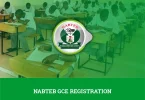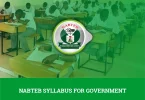The National Business and Technical Examinations Board (NABTEB) has released the official syllabus for all subjects in preparation for the upcoming exams. This syllabus serves as a helpful guide, showing candidates the specific topics they need to focus on during their studies. It has been carefully organized to help improve students’ performance by directing their attention to the important areas.
Students who use the syllabus as part of their revision tend to be more confident and better prepared for the exam. If you are planning to write Mathematics in the next NABTEB examination, having the NABTEB Syllabus for Mathematics is very important.
The NABTEB Syllabus for Mathematics highlights all the major topics you should expect in both Paper I and Paper II. Continue reading to get the full NABTEB Mathematics syllabus.
Examination Structure
The exam is divided into two papers:-
Paper I (002-1): Duration is 1½ hours and carries 50 marks. It consists of 50 multiple-choice questions and is compulsory for all candidates.
Paper II (002-2): Duration is 2½ hours with a total of 100 marks, divided into three sections:
- Section A (General Mathematics): Includes five compulsory questions for all candidates. This section is worth 40 marks.
- Section B: Contains six questions, out of which candidates must answer any four. However, candidates offering Secretarial or Business options should answer only two. Each question is worth 15 marks.
- Section C (Commercial Mathematics): Intended only for Secretarial and Business candidates. It contains four questions, from which candidates must answer any two. Each question carries 15 marks.
Candidates should have a good understanding of standard units like length, area, volume, mass, and their abbreviations. Currency units will be defined where necessary.
NABTEB Syllabus For Mathematics
1. Number Bases
Objective: Count and perform arithmetic operations in different bases.
Content:
- Conversion between number bases.
- Addition, subtraction, multiplication, and division in different bases (excluding fractions).
- Modular arithmetic.
Remarks:
- Emphasize place value vs additive system (e.g. 4520 = 4×1000 + 5×100 + 2×10 + 0).
- Relate to local systems like market days.
2. System Internationale (S.I.) Units
Objective: Solve problems involving S.I. and Imperial units.
Content:
- Conversion between units (mm to m, m to km, etc.).
- Time conversions (hours, minutes, seconds).
Remarks:
- Emphasize basic S.I. units.
- Highlight practical advantages over imperial units.
3. Fractions
Objective: Solve arithmetic problems with vulgar and decimal fractions.
Content:
- Convert between decimals and vulgar fractions.
- Perform addition, subtraction, multiplication, and division.
Remarks:
- Limit decimals to two places.
- Emphasize relationships like ½ × ⅕ = 0.1, and ⅖ = 0.4 = 40%.
4. Standard Forms
Objective: Express numbers in standard forms and correct significant figures.
Content:
- Standard forms (A × 10^n).
- Rounding to decimal places and significant figures.
5. Ratio and Proportion
Objective: Solve problems involving ratio and proportion.
Content:
- Direct and inverse proportion.
- Representative fraction.
Remarks:
- Relate to science and technical drawing.
6. Variation
Objective: Solve problems involving direct, inverse, joint, and partial variations.
Content:
- Application in practical problems.
7. Percentages, Profit & Loss
Objective: Apply percentages in real-life situations.
Content:
- Conversion between fractions, decimals, and percentages.
- Profit/loss calculations.
Remarks:
- Include real-life tools like cheques, money orders, etc.
8. Simple Interest
Objective: Solve simple interest problems.
Content:
- Formula: I = PRT/100.
Remarks:
- Emphasize transformation to find P, R, or T.
9. Logarithms
Objective: Apply logarithms and tables in calculations.
Content:
- Use base 10 logs and antilogs.
- Operations: multiplication, division, powers, roots.
Remarks:
- Practice with logarithm tables.
10. Indices
- Objective: Use the laws of indices in calculations.
- Content:
- Laws of indices (product, quotient, power).
- Meaning of a⁰, a⁻ˣ, a¹/ˣ.
Remarks:
- Relate to science and encourage discovery.
11. Relationship between Indices and Logarithms
Objective: Understand their inverse relationship.
Content:
- y = 10^x and x = log₁₀y.
- Graphs of y = 10^x (0 < x < 1).
Remarks:
- Use only the basic graph.
12. Rules of Logarithms
Objective: Identify and apply log rules.
Content:
- log₁₀(xy) = log₁₀x + log₁₀y.
- log₁₀(x/y) = log₁₀x – log₁₀y.
- log₁₀(xⁿ) = nlog₁₀x.
Remarks:
- Apply in compound interest and investment problems.
13. Arithmetic and Geometric Progressions
Objective:
- Identify sequences and find nth terms.
- Calculate sums of A.P. and G.P.
Content:
- Definitions, formulas for nth term and sum.
Remarks:
- Limit scope to basic secondary level.
14. Sets
Objective: Solve set problems using Venn diagrams.
Content:
- Set notation, union, intersection, complement.
Remarks:
- Do not use more than 3 sets.
- Use for classification and comparison.
15. Logical Reasoning
Objective: Evaluate logical statements and arguments.
Content:
- Truth, negation, implication, equivalence.
- Use symbols: ~, ⇒, ⇔.
Remarks:
- Use Venn diagrams where possible.
16. Surds
Objective: Simplify and rationalize simple surds.
Content:
- Forms like √b, a√b.
Remarks:
- Keep within the scope of rationalization.
17. Algebraic Processes
Objective: Perform operations using algebraic symbols.
Content:
- Like/unlike terms, brackets, substitutions.
- Use symbols to form and evaluate expressions.
Remarks:
- Emphasize collection of like terms and substitution.
18. Simple Equations
Objective: Solve simple equations.
Content: One-variable linear equations.
- Demonstrate equality using balance concept.
Remarks:
- Avoid saying “cancel out”; explain logically.
19. Linear Simultaneous Equations
Objective: Solve linear simultaneous equations in two variables.
Content:
- Elimination and substitution methods.
- Word problem applications.
Remarks:
- Encourage checking answers through substitution.
20. Algebraic Expressions
Objective:
- Solve simple equations with fractions.
- Factorize quadratic expressions.
Content:
- HCF and LCM.
- Simplify algebraic fractions.
- Factorization of quadratic expressions.
Remarks:
- Practice with a variety of expressions.
Examination Materials & Guidelines
- Candidates may use approved mathematical/statistical tables during the exam. Schools are advised to make these tables available for practice.
- Students should bring a complete set of mathematical instruments and a ruler. Borrowing in the exam hall is not allowed.
- Only noiseless, cordless, non-programmable calculators are permitted.
If needed, the following will be provided during the exam:-
- Graph paper (2mm square grid)
- Plain drawing sheets for construction tasks.
Every topic listed could appear in the exam, so make sure you cover them all thoroughly during your study time. To strengthen your preparation, use the recommended textbooks and practice with past questions.
If you are struggling with any topic or have questions, don’t hesitate to leave a comment. Do you know someone else preparing for NABTEB exams? Share this post to help them out. If you need the syllabus for other subjects, feel free to browse our page where you will find them all.







Leave a Comment